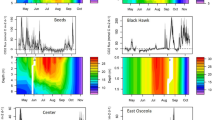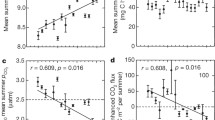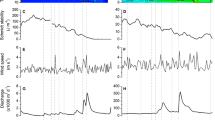Abstract
We explored the whole-lake accumulation of CO2 during winter ice cover and in the hypolimnion during summer stratification, in 15 temperate and boreal lakes, and how these processes vary with lake trophic state and morphometry. We further estimated an annual CO2 budget for each lake that incorporates the fluxes resulting from winter ice-cover and summer hypolimnetic CO2 accumulation to assess their relative importance. The volumetric rates of CO2 accumulation during the winter ice cover ranged from 4.1 to 42.1 mg C m−3 d−1, and from 9.3 to 54.5 mg C m−3 d−1 in the summer hypolimnion, and both varied mainly as a function of water temperature. The total CO2 accumulation at the end of winter/summer was most strongly related to lake mean depth and was significantly greater under ice than in the hypolimnion. This greater CO2 accumulation resulted in relatively high and unvarying spring outflux, averaging 404 mg C m−2 d−1 (C.V. 27%). Significant hypolimnetic CO2 accumulation also resulted in relatively high fluxes (average 228 mg C m−2 d−1) during autumnal mixing, which were more variable (C.V. 43%) than spring fluxes. Average fluxes were lowest and most variable in summer (198 mg C m−2 d−1, C.V. 46%). The net annual CO2 flux ranged from 14 to 68 g C m−2 y−1, and was positively related to DOC concentration. The winter ice-cover CO2 accumulation accounted from 3 to 80% (average 17%) of the annual CO2 flux, whereas summer hypolimnetic accumulation accounted for a smaller but still significant proportion (from 1.4 to 46%). These winter and summer hypolimnetic CO2 accumulations are released to the atmosphere through short but intense emission bursts that are rarely captured in regular lake sampling schemes, yet they have the potential to profoundly influence the annual lake CO2 budgets in northern landscapes.






Similar content being viewed by others
References
Åberg J, Jansson M, Jonsson A. 2010. Importance of water temperature and thermal stratification dynamics for temporal variation of surface water CO2 in a boreal lake. J Geophys Res 115:G02024.
Amorocho J, DeVries JJ. 1980. A new evaluation of the wind stress coefficient over water surfaces. J Geophys Res 85:433–42.
Babin J, Prepas EE. 1985. Modelling winter oxygen depletion rates in ice-covered temperate zone lakes in Canada. Can J Fish Aquat Sci 42:239–49.
Baines SB, Pace ML. 1991. The production of dissolved organic matter by phytoplankton and its importance to bacteria: patterns across marine and freshwater systems. Limnol Oceanogr 36:1078–90.
Carlsson P, Caron DA. 2001. Seasonal variation of phosphorus limitation of bacterial growth in a small lake. Limnol Oceanogr 46:108–20.
Cole JJ, Caraco NF, Kling GW, Kratz TK. 1994. Carbon dioxide supersaturation in the surface waters of lakes. Science 265:1568–70.
Cole JJ, Prairie YT, Caraco NF, McDowell WH, Tranvik LJ, Striegl RG, Duarte CM, Kortelainen P, Downing JA, Middelburg JJ, Melack J. 2007. Plumbing the global carbon cycle: integrating inland waters into the terrestrial carbon budget. Ecosystems 10:172–85.
Cole JJ, Prairie YT. 2009. Dissolved CO2. In: Likens GE, Ed. Encyclopedia of inland waters, Vol. 2. Oxford: Elsevier. p 30–4.
Cornett R, Rigler F. 1987. Vertical transport of oxygen into the hypolimnion of lakes. Can J Fish Aquat Sci 44:852–8.
del Giorgio PA, Williams PJB. 2005. The global significance of respiration in aquatic ecosystems: from single cells to the biosphere. In: del Giorgio PA, Williams PJB, Eds. The global significance of respiration in aquatic ecosystems: from single cells to the biosphere. New York: Oxford University Press. p 267–303.
Demarty M, Bastien J, Tremblay A. 2011. Annual follow-up of gross diffusive carbon dioxide and methane emissions from a boreal reservoir and two nearby lakes in Québec, Canada. Biogeosciences 8:41–53.
Felip M, Pace ML, Cole JJ. 1996. Regulation of planktonic bacterial growth rates: the effects of temperature and resources. Microb Ecol 31:15–28.
Ferland M-E, del Giorgio PA, Teodoru CR, Prairie YT. 2012. Long-term C accumulation and total C stocks in boreal lakes in northern Québec. Global Biogeochem Cycles . doi:10.1029/2011GB004241.
Houser J, Bade D, Cole J, Pace M. 2003. The dual influences of dissolved organic carbon on hypolimnetic metabolism: organic substrate and photosynthetic reduction. Biogeochemistry 64:247–69.
Huotari J, Ojala A, Peltomaa E, Pumpanen J, Hari P, Vesala T. 2009. Temporal variations in surface water CO2 concentration in a boreal humic lake based on high-frequency measurements. Boreal Environ Res 14:48–60.
Jähne B, Münnich KO, Bösinger R, Dutzi A, Huber W, Libner P. 1987. On the parameters influencing air-water gas exchange. J Geophys Res 92:1937–49.
Jonsson A, Karlsson J, Jansson M. 2003. Sources of Carbon dioxide supersaturation in clearwater and humic lakes in Northern Sweden. Ecosystems 6:224–35.
Kankaala P, Huotari J, Tulonen T, Ojala A. 2013. Lake-size dependent physical forcing of carbon dioxide and methane effluxes from lakes in a boreal landscape. Limnol Oceanogr 58:1915–30.
Karlsson J, Giesler R, Persson J, Lundin E. 2013. High emission of carbon dioxide and methane during ice thaw in high latitude lakes. Geophys Res Lett . doi:10.1002/grl.50152.
Kelly CA, Fee E, Ramlal PS, Rudd JWM, Hesslein RH, Anema C, Schindler EU. 2001. Natural variability of carbon dioxide and net epilimnetic production in the surface waters of boreal lakes of different sizes. Limnol Oceanogr 46:1054–64.
Kling G, Kipphut G, Miller M. 1991. Arctic lakes and streams as gas conduits to the atmosphere: implications for tundra carbon budgets. Science 251:298–301.
Klug JL, Richardson DC, Ewing HA, Hargreaves BR, Samal NR, Vachon D, Pierson DC, Lindsey AM, O’Donnell DM, Effler SW, Weathers KC. 2012. Ecosystem effects of a tropical cyclone on a network of lakes in northeastern North America. Environ Sci Technol 46:11693–701.
Kortelainen P, Rantakari M, Huttunen JT, Mattsson T, Alm J, Juutinen S, Larmola T, Silvola J, Martikainen PJ. 2006. Sediment respiration and lake trophic state are important predictors of large CO2 evasion from small boreal lakes. Glob Change Biol 12:1554–67.
Lapierre J-F, del Giorgio PA. 2012. Geographical and environmental drivers of regional differences in the lake pCO2 versus DOC relationship across northern landscapes. J Geophys Res 117:G03015.
López Bellido J, Tulonen T, Kankaala P, Ojala A. 2009. CO2 and CH4 fluxes during spring and autumn mixing periods in a boreal lake (Pääjärvi, southern Finland). J Geophys Res 114:G04007.
Marchand D, Prairie YT, del Giorgio PA. 2009. Linking forest fires to lake metabolism and carbon dioxide emissions in the boreal region of Northern Quebec. Glob Change Biol 15:2861–73.
Maurice CF, Bouvier T, Comte J, Guillemette F, del Giorgio PA. 2010. Seasonal variations of phage life strategies and bacterial physiological states in three northern temperate lakes. Environ Microbiol 12:628–41.
Michmerhuizen CM, Striegl RG, Mcdonald ME. 1996. Potential methane emission from north-temperate lakes following ice melt. Limnol Oceanogr 41:985–91.
Ojala A, López Bellido J, Tulonen T, Kankaala P, Huotari J. 2011. Carbon gas fluxes from a brown-water and a clear-water lake in the boreal zone during a summer with extreme rain events. Limnol Oceanogr 56:61–76.
Prairie Y, Bird D, Cole J. 2002. The summer metabolic balance in the epilimnion of southeastern Quebec lakes. Limnol Oceanogr 47:316–21.
Rantakari M, Kortelainen P. 2005. Interannual variation and climatic regulation of the CO2 emission from large boreal lakes. Glob Change Biol 11:1368–80.
Raymond PA, Hartmann J, Lauerwald R, Sobek S, McDonald C, Hoover M, Butman D, Striegl R, Mayorga E, Humborg C, Kortelainen P, Dürr H, Meybeck M, Ciais P, Guth P. 2013. Global carbon dioxide emissions from inland waters. Nature 503:355–9.
Riera J, Schindler J, Kratz T. 1999. Seasonal dynamics of carbon dioxide and methane in two clear-water lakes and two bog lakes in northern Wisconsin, USA. Can J Fish Aquat Sci 274:265–74.
Rippey B, McSorley C. 2009. Oxygen depletion in lake hypolimnia. Limnol Oceanogr 54:905–16.
Roehm CL, Prairie YT, del Giorgio PA. 2009. The pCO2 dynamics in lakes in the boreal region of northern Québec. Canada: Global Biogeochem Cycles. doi:10.1029/2008GB003297
Sobek S, Algesten G, Bergström A-K, Jansson M, Tranvik LJ. 2003. The catchment and climate regulation of pCO2 in boreal lakes. Glob Change Biol 9:630–41.
Striegl R, Kortelainen P. 2001. Carbon dioxide partial pressure and 13C content of north temperate and boreal lakes at spring ice melt. Limnol Oceanogr 46:941–5.
Striegl R, Michmerhuizen C. 1998. Hydrologic influence on methane and carbon dioxide dynamics at two north-central Minnesota lakes. Limnol Oceanogr 43:1519–29.
Tranvik L, Downing J, Cotner J. 2009. Lakes and reservoirs as regulators of carbon cycling and climate. Limnol Oceanogr 54:2298–314.
Vachon D, del Giorgio PA. 2014. Whole-lake CO2 dynamics in response to storm events in two morphologically different lakes. Ecosystems 17:1338–53.
Vachon D, Prairie YT. 2013. The ecosystem size and shape dependence of gas transfer velocity versus wind speed relationships in lakes. Can J Fish Aquat Sci 70:1757–64.
Wanninkhof R, Knox M. 1996. Chemical enhancement of CO2 exchange in natural waters. Limnol Oceanogr 41:689–97.
Wanninkhof R. 1992. Relationship between wind speed and gas exchange over the ocean. J Geophys Res 97:7373–82.
Acknowledgments
We wish to thank Lisa Fauteux, Marie-Eve Ferland, François Guillemette, Pierre Marcoux, Martine Camiré, Annick St-Pierre, Jérôme Comte and Environnement Illimité for field support, and Catherine Beauchemin and Alice Parkes for help in the lab. Thanks to Jean-François Hélie and Roxane Maranger for their advice during project planning, and two anonymous reviewers for their insightful comments. This research was supported by funds from the Environmental Division of Hydro Québec through the Eastmain-1 Project, the Natural Sciences and Engineering Research Council of Canada (NSERC), and by the Quebec fund for natural sciences and technologies (FQRNT) through a graduate scholarship to VDR.
Author information
Authors and Affiliations
Corresponding author
Additional information
Author Contributions
All authors contributed to data analysis and writing. VDR, YTP and PdG designed the study and performed research.
Rights and permissions
About this article
Cite this article
Ducharme-Riel, V., Vachon, D., del Giorgio, P.A. et al. The Relative Contribution of Winter Under-Ice and Summer Hypolimnetic CO2 Accumulation to the Annual CO2 Emissions from Northern Lakes. Ecosystems 18, 547–559 (2015). https://doi.org/10.1007/s10021-015-9846-0
Received:
Accepted:
Published:
Issue Date:
DOI: https://doi.org/10.1007/s10021-015-9846-0




